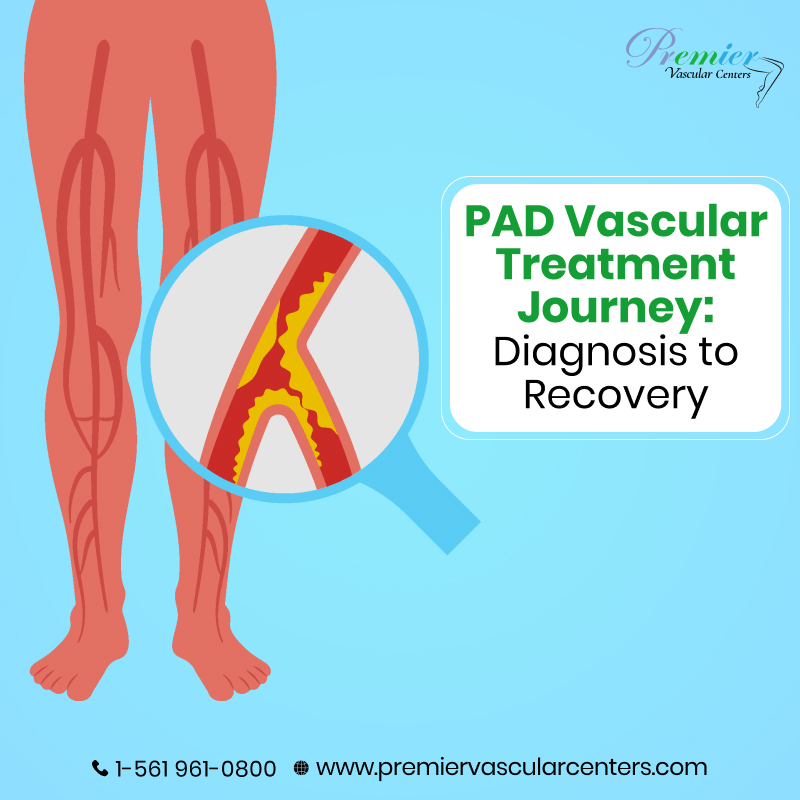Peripheral Arterial Disease (PAD) is a vein condition where narrowed arteries restrict blood flow and the limbs do not receive sufficient blood. It is a serious disease that, if left untreated, will cause severe pain and slower wound healing. And in extreme cases, you can either lose mobility or might need amputation. But you can avoid it.
Because most vein care clinics now offer modern PAD vascular treatment in Boca Raton and other places that are effective. What you need to do is understand and be aware of the journey from diagnosis to recovery to be prepared for each stage. Be confident in your care plan!
The Journey of PAD Vascular Treatment from Diagnosis to Recovery
We never know when or how it will happen. What we can do is stay alert and informed. And therefore the following generic explanation of the steps of PAD diagnosis and treatment can be helpful for you or someone in your family. Give this a read now so that you make the right decisions in the future!
Step 1: Recognizing the Symptoms
You won’t know anything without the symptoms. For PAD too, you will most likely face symptoms of cramping while walking, persistent leg pain, or slow-healing sores on the feet and ankles. It is common for people to mistake them as warning signs for muscle fatigue or aging, but most of the time they’re actually blood circulation problems. This is when you should visit a trusted vein treatment clinic so that your symptoms are evaluated early, minimizing the risk of complications.
Step 2: Accurate Diagnosis
To diagnose PAD, vein specialists will consider your medical history and complete a physical exam, in addition to any advanced imaging.Your vein specialist may order an ankle-brachial index test to assess blood flow, or they may recommend ultrasound or angiogram for a better visual of the arteries.A timely, accurate diagnosis leads to the treatment plan, which allows vein specialists to assess how advanced the disease is and how best to treat it.
Step 3: Personalized Treatment Planning
No two PAD cases are identical. A vein specialist tailors treatment plans to the patient’s health, lifestyle, and disease progression. For some, lifestyle changes like quitting smoking, exercising, and controlling diabetes may be the first line of defense. Medications to manage blood pressure or cholesterol often support these adjustments. For others with more advanced blockages, minimally invasive procedures such as angioplasty or stent placement become necessary to restore blood flow.
Step 4: Endovascular and Surgical Options
Minimally invasive endovascular techniques are the focus of modern PAD vascular treatment. Catheters, balloons, and stents are used by specialists to open constricted arteries and enhance circulation through tiny incisions. Compared to traditional surgery, these procedures usually involve less discomfort and shorter recovery periods. However, bypass surgery might still be the best course of action in extreme situations where blockages are widespread. Restoring normal blood flow and lowering the chance of serious complications are still the objectives.
Step 5: Recovery and Lifestyle Adjustments
Recovery from PAD treatment is not just about healing incisions. It is about adopting healthier habits to prevent recurrence. Patients are encouraged to stay physically active, eat heart-healthy foods, and follow medication regimens closely. Regular follow-ups at your chosen vein treatment clinic in Boca Raton allow specialists to track progress, adjust treatment if needed, and ensure long-term success. Recovery is a partnership between the patient and the care team, with both playing active roles in maintaining vascular health.
Step 6: Ongoing Monitoring and Prevention
PAD is actually a chronic condition, so only getting the treatment is not the end! To make sure the treatment remains successful, monitoring remains essential for all patients. You need to go through regular screening so that the doctor can detect if there are any new blockages. Early detection helps manage the issue promptly so that it does not become serious. Vein specialists also suggest patients continue the suggested lifestyle modifications alongside the medical management. This is because vigilance and prevention are both crucial for ensuring proper circulation and overall health.
So amputation is not the only option. Click here to know now how PAD can be reversed.
Conclusion
As you can see, there are several steps of PAD from diagnosis to recovery. So you need to be aware of what happens at each stage so that you can take the right action as needed. Clinics offering PAD vascular treatment in Boca Raton deliver expert guidance on how patients can manage their own vascular health and reduce PAD risks. So choose the right specialists, credible clinics like Premier Vascular Centers. Because they take precise care of everything, from initial consultation to post-treatment care!

